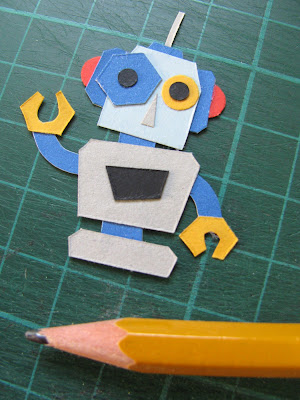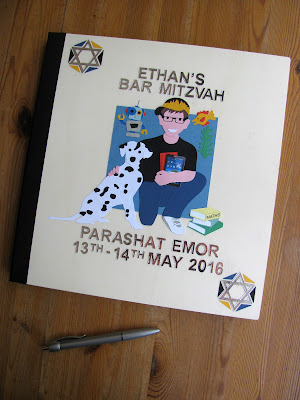Ethan celebrated his Bar Mitzvah in the middle of May. His Mum asked me to create an album that all their guests could sign at the start of his Bar Mitzvah weekend. Ethan's various hobbies include reading, playing video games on his Samsung Galaxy tablet, maths, dogs, marine biology, robotics and the self-defence system Krav Maga. Oh, and Mum pointed out to me that he wears a hat ALL the time!
I have shown Ethan wearing his favourite black and yellow hat, with a Dalmatian next to him and with his tablet and a book in his arms. He is wearing a black t-shirt, the colour he wears for Krav Maga. Behind him is a robot, to illustrate his interest in robotics, and a fish and some seaweed, representing marine biology. A small pile of books next to him includes a maths book, one of Ethan's favourite subjects.
The silver lettering spells out his name, the words Bar Mitzvah, his parasha (the Torah portion that is read on Shabbat) and the date of his Bar Mitzvah. A Star of David, or Magen David, in two corners adds a Jewish element.
As well as decorating the cover of the album, I also embellished five pages inside the book. The first page showed a small pile of books, since Ethan is such a keen reader. Next I pictured his Samsung tablet and his favourite video game, Fallout 4, followed by a page that displayed some colourful maths symbols. Mum had initially told me that Ethan's favourite dogs were Dalmatians but, as I was working on the album, the family got their own dog, a Weimaraner that they have called Luna. Instead of another Dalmatian, I crafted a cute blue-eyed puppy just like Luna to go on one of the inside pages. Finally, the last page was devoted to Ethan's interest in marine biology, below. I created some unusual-looking fish and some seaweed, and cut some tiny bubbles to create the impression of water.
As well as decorating the cover of the album, I also embellished five pages inside the book. The first page showed a small pile of books, since Ethan is such a keen reader. Next I pictured his Samsung tablet and his favourite video game, Fallout 4, followed by a page that displayed some colourful maths symbols. Mum had initially told me that Ethan's favourite dogs were Dalmatians but, as I was working on the album, the family got their own dog, a Weimaraner that they have called Luna. Instead of another Dalmatian, I crafted a cute blue-eyed puppy just like Luna to go on one of the inside pages. Finally, the last page was devoted to Ethan's interest in marine biology, below. I created some unusual-looking fish and some seaweed, and cut some tiny bubbles to create the impression of water.
"[The album] looks lovely!" Mum wrote to me. "Ethan loves it."






















































































